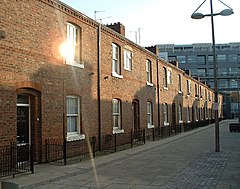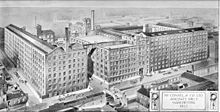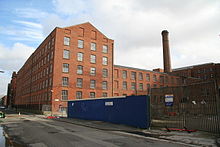Ancoats
| Ancoats | |
|---|---|
 Ancoats is a formerindustrial districtbeinggentrifiedas a residential area. | |
Location withinGreater Manchester | |
| OS grid reference | SJ847985 |
| Metropolitan borough | |
| Metropolitan county | |
| Region | |
| Country | England |
| Sovereign state | United Kingdom |
| Post town | MANCHESTER |
| Postcode district | M4 |
| Dialling code | 0161 |
| Police | Greater Manchester |
| Fire | Greater Manchester |
| Ambulance | North West |
| UK Parliament | |
Ancoatsis an area ofManchester,England, next to theNorthern Quarter,the northern part ofManchester city centre.
HistoricallyinLancashire,Ancoats became a cradle of theIndustrial Revolutionand has been called "the world's firstindustrial suburb".[1]For many years, from the late 18th century onwards, Ancoats was a thriving industrial district. The area suffered accelerating economic decline from the 1930s and depopulation in the years after theSecond World War,particularly during theslum clearancesof the 1960s.
Since the 1990s, Ancoats'industrial heritagehas been recognised and its proximity to the city centre has led to investment and substantial regeneration. The southern part of the area was branded New Islington by property developers Urban Splash, with redevelopment centred on theDaily Express Building.
In 2021, a plaque was put in place acknowledging Ancoats' status as aLittle Italy.[2]
For the purpose of local government elections, the area is part of theAncoats and Beswickward onManchester City Council.
History
[edit]Medieval
[edit]The name Ancoats is likely to have derived from theOld Englishana cots,meaning "lonely cottages". The settlement is first recorded asElnecotin 1212.[3]In a survey of 1320, Ancoats was recorded as one of the eighthamletswithin thetownshipof Manchester in theancient parish of Manchesterwithin thehundred of Salford;[4]the hamlet probably consisted of a few cottages and farmhouses centred on what is now Ancoats Lane, Butler Lane and Newton Lane.[4]During the medieval period,Ancoats Hallwas built.[4]Land in Ancoats was bequeathed in the 14th century by Henry de Ancotes. The village covered the area of land that roughly lies between theRiver Medlockand theRiver Irk.
Industrial Revolution
[edit]This articleneeds additional citations forverification.(July 2022) |
Cotton
[edit]

Survey work for theRochdale Canalwas carried out byJames Brindleyin 1765. The knowledge that its construction would make the transport of raw materials and finished goods more convenient gave industrialists the confidence to build their cotton mills. The first mills were built in Ancoats as early as 1790. In 1792 commissioners were established for the improvement of the township of Manchester, which included Ancoats. Towards the end of the 18th century steam power was first used to power thecotton mills.Some of the earliest mills of this period wereMurray's Mills,which were established next to the Rochdale Canal on Union Street (now Redhill Street) offGreat Ancoats Street,by Adam and George Murray in 1798. Later, they became known as Ancoats Mills when they were operated by McConnel & Company Ltd. The streets of Ancoats were also laid out during the latter part of the 18th century, with little development taking place other than small houses and shops along Great Ancoats Street and Oldham Road (A62 road).
From the opening of the Rochdale Canal in 1804 the development of mills continued on a much larger scale. Mills in Ancoats included Victoria Mills, Wellington Mill, Brunswick Mill, India Mills, Dolton Mills, Lonsdale Mills, Phoenix Mill, Lloydsfield Mill, Sedgewick Mill, Decker Mill (owned by the Murray brothers), New Mill,Beehive Mill,Little Mill, Paragon Mill,Royal Milland Pin Mill.
Ancoats grew rapidly to become an important industrial centre and as a result it also became a densely populated area.[5]By 1815 Ancoats was the most populous district in Manchester.[6]Streets ofback-to-back housesand court dwellings were rapidly built. For the poorest members of the community, houses were split and cellars let separately. Public health was a concern; a survey motivated by the fear of acholeraoutbreak showed that over half of homes in Ancoats had no private plumbing, and over half of streets were not cleaned.[7]
By the middle of the 19th century Ancoats was densely developed. In 1851 Ancoats' total population was 53,737, larger than towns such asBuryandBlackburn.However, despite this large population, Ancoats lacked public buildings and spaces. There were no parks and the only public buildings were a few churches and a dispensary. As late as 1821 there had been no churches.[7]
Foundries
[edit]Cotton was not the only industry in the locality, as foundries and engineering factories were required to produce the machinery needed by the mills. The largest of these were those operated by the brothers John Muir Hetherington and Thomas Ridley Hetherington, which were established in 1830. Eventually the company became known asJohn Hetherington and Sons Ltdand the principal factory was at Vulcan Works on Pollard Street. The company was also the proprietor of Curtis, Sons & Company, which was established in 1804 at the Phoenix Works, which were on both sides of Chapel Street (now Chapeltown Street). On one side of the street there was a brass and iron works and on the other side there was a machinery factory. Hetherington's produced a huge range of machinery for the textile industry that included machinery for opening, preparing, spinning and doubling cotton, cotton waste, wool and worsted. Their speciality was a machine called a Combined Opener and Scutcher that was very effective in the cleaning of most types of cotton without damaging the staple or losing serviceable fibre.
Glass works
[edit]Possibly the least known, but vitally important, industry in Ancoats was the manufacture offlint glass.More than 25 glassworks have been identified in Manchester, all built during the 19th century, and many of these were in Ancoats. Thomas Percival and William Yates established one of these on Union Street (now Redhill Street) in 1844. The works was equipped with two furnaces (later three), an annealing house, workshops, a warehouse and offices. In 1852, Thomas Vickers joined the company and William Yates left in 1862. After this, the company became known as Percival Vickers British and Foreign Flint Glass Works. It made a large range of glassware that included tumblers, wine glasses, decanters, vases, celery vases, salts and cake stands. One of the buildings in Ancoats, the Flint Glass Works, still exists today and has been converted into serviced offices.[8]
Other industries
[edit]At the top of Stony Brow (later Junction Street and now Jutland Street) there was the multi-storey drysalters factory of Thomas Hassall. It was said that this was the only drysalters in England and it supplied rock salt, moss litter and all kinds of other things. There were also chemical works (especially alum), floor-cloth works and finishing and calendering works that rolled cloth to smooth or glaze it.
Later Victorian period
[edit]Immigration
[edit]During the 19th century, due to political and economic circumstances, manyItaliansleft Italy for a more secure life. Most of the Italians who arrived in Ancoats were fromLiguria,in northwest Italy, andFrosinoneandGaeta,southeast of Rome.[9]Over the next hundred years they created what became known asAncoats Little Italy.Large numbers ofIrishalso settled in Ancoats. According to the1851 censusalmost half of the men living in Ancoats had been born in Ireland.[7]
Religion and poor relief
[edit]The Methodists were very active in Ancoats at the end of the 19th century – they ran both a men's workhouse and women's night shelter (with coffee tavern). There were dozens of pubs, however, of which only five buildings remain and only two of these are still open. TheSalvation Armyhad a presence in Ancoats, with theStar HallandCrossley Hospitalin Pollard Street. Crossley Court, flats belonging to the Salvation Army Housing Association, now stands on the site.Ancoats Hospitalwas located on Old Mill Street, adjacent to theAshton Canal.This has been closed to patients for some time, and is currently under residential development.Thomas Horsfallopened theManchester Art Museum,a free art gallery, in Ancoats in 1886. His aim was to create a morally elevating alternative to pubs.[10]
Given the historically high levels of Irish and Italian immigration, a large proportion of Ancoats' population has been Roman Catholic.[citation needed]Ancoats had a colony of Italians from 1835 and many of them became successful in business; e.g. the Ronchetti family were opticians, instrument makers and also waterproof manufacturers; J. L. Casartelli was an optician, instrument maker and manufacturing chemist.[11]
Early 20th century
[edit]Aircraft were manufactured in Ancoats and this factory was at Brownsfield Mill, which was on the corner of Great Ancoats Street and Binns Place at the point where the Rochdale Canal passes below Great Ancoats Street. Here,Avroestablished a factory in 1910.[12][13]Men from Ancoats serving in the Army in France during theFirst World Warwere aware that aeroplanes they saw in action above them had been made in Ancoats.
In 1939, theDaily Expressnewspaper company opened new premises, which were built in the "functional" style, using new curtain-wall technology identical to that on the company'sDaily Express BuildinginFleet Street,London and inGlasgow.
Post-war decline
[edit]The substantial economic activity generated by such a concentration of mills was halted by the slump in the cotton industry in the 1930s. Thereafter, the prosperity of the mills declined steadily, and the only new industry to establish itself in Ancoats was newspaper printing.[14]Ancoats, like neighbouringMiles PlattingandCollyhurst,became very run down and notorious for deprivation and crime. Cotton spinning ceased in Manchester and other textile-related uses were found for the mills: clothes manufacture, machinery repairs and warehouses for imported goods' rag trade.
The 1960s witnessed further decline as, during the mass clearance of the area's terraced homes, the population was re-housed in the north and east of the city. The mills, attracting decreasing rents, fell into disrepair.
Despite the clearance of Victorian terraces during the early 1960s and the relocation of most households tooverspill estateslikeHattersleyandGamesley,many new houses and flats were built in Ancoats by the local council. Inevitably, the local area's population was lower by 1970 than it had been a decade earlier, as the new housing developments were more spaced out, and some former residential areas had been redeveloped for commercial and industrial use.
Newspaper printing, one of Ancoats' 20th century industries, fell victim to changes in technology, with theDaily Expressceasing to be published from its famous black glass building in 1989. The closure of Express Printers was also the start of Ancoats' renewal, as the impact of low investment and increasing unemployment became recognised.[15]
Regeneration
[edit]In June 1989, Manchester City Council designated land bounded by Great Ancoats Street, Oldham Road, Kemp Street, Wadeford Close, Jersey Street and the Rochdale Canal into a conservation area where a number of buildings werelisted.While it protected a number of historically significant buildings, it made regeneration more difficult. In 1990, the Eastside Regeneration was formed, the first organisation created to regenerate the area. The Eastside Regeneration in turn spawned the formation of the Ancoats Build Preservation Trust in 1995 and the Ancoats Urban Village Company in 1996.[15]Unfortunately, Manchester's bids for the 1996 and 2000 Olympics caused speculative buying of property in Ancoats in the early 1990s. When the bids failed the buildings were abandoned and decay accelerated. By 1998 it was estimated that 80% of business floor space in Ancoats was vacant.[16]
In 2000, the government accepted the £250mNew Islington Projectto redevelop a 0.125-square-kilometre (31-acre) section of land between theRochdaleandAshton Canals.To assist regeneration by preventing speculative purchase of land theNorth West Development Agencymade acompulsory purchase orderof land in the area. A target population of 15,000 by 2010 was set for the Ancoats area.[15]
Landmarks
[edit]

The following Listed buildings are in the Ancoats conservation area:
- Beehive Mill,Jersey Street. Built between 1820-24. Grade II*.
- Brownsfield Mill, Great Ancoats Street. Built ca. 1825. Grade II*.
- Church of St. Peter, Blossom Street. Designed by Isaac Holden & Son, 1859–60. Grade C.
- Crown and Kettlepublic house, Oldham Road. Built early 19th century. Grade II.
- Daily Express Building,Great Ancoats Street. Designed by Sir Owen Williams, 1939. Grade II.
- Jersey Mill, Jersey Street. Built in 1804. Grade II*.
- Mill to north-west corner of the junction Redhill Street/Bengal Street. Built early 19th century and 1842. Grade II*.
- Murray's Mill(main block), Redhill Street. Built 1798. Grade II*.
- Murray's Mill, Murray Street. Built ca. 1800. Grade II.
- Paragon Mill, Jersey Street. Built ca. 1912. Grade II*.
- Royal Mill,Henry Street. Built ca. 1912. Grade II*.
- Sedgwick Mill, Redhill Street. Probably designed by Sir William Fairbairn, 1818. Grade II.
- Sedgwick New Mill, Redhill Street. Built ca. 1858. Grade II.
- Victoria Square, Oldham Road. Designed by Spalding & Cross, 1889–1894. Grade II.
- St Michael's RC church, ca. 1869.
Culture
[edit]- Hallé St Peter'sis a rehearsal and education venue for theHallé Orchestra,based on the grade IIlistedformer St Peter's Church, Blossom Street.[17]
- Sankeysnightclub was in Beehive Mill on Radium Street. It closed officially in 2018.
- Hallé St Michael's, a community space for the Hallé's artistic and educational activities, is on George Leigh Street.
Cultural references
[edit]Ancoats has been the setting for several novels byHoward Spring,includingFame is the Spur.It was also the setting forIsabella Banks' novelThe Manchester Man.
Ancoats was mentioned in the lyrics ofBrian and Michael's 1978 UK number one hit, "Matchstalk Men and Matchstalk Cats and Dogs",a tribute toL. S. Lowry.
A fictional singer,Ann Coates,is credited with backing vocals on the 1986 single "Bigmouth Strikes Again"bythe Smiths.
The British trip-hop bandThe Baby Namboosreleased a song and album titledAncoats 2 Zambiain 1999. The single was famously remixed by drum and bass producerDillinja.
The track "Ancodia" by808 Statewas named after the area, where two of the band members lived at the time.
Notable people
[edit]- Hugh Oldham(1452–1519), Bishop of Exeter from 1505 to his death in 1519. He was born to a family of minorgentrywho lived in Ancoats. Bishop Oldham was a patron of education who foundedManchester Grammar Schooland was a major benefactor ofCorpus Christi College, Oxford.
- Richard Buxton(1786–1865), an impoverished shoemaker from Ancoats. He published a botanical guide to the plants to be found around Manchester in 1849.[18]
- William Hepworth Dixon(1821–1879), the historian and travel writer, born in Great Ancoats[clarification needed]
- John Sibbit(1895–1950), Britishtrack cyclistwho won a silver medal at the1928 Summer Olympics[19]
- Bernard Manning(1930–2007), stand-up comedian
- Foo Foo Lammar(1937–2003), drag queen. She was born in Ancoats and later lived in the area's Piccadilly Village apartments.[20][21][22]
- John Henshaw(born 1951), actor. Notable for playing Ken, the pub landlord in the TV seriesEarly Doors.
- Lesley Ann Downey, the youngest victim of theMoors murders,was from Ancoats. The fourth of the five Moors Murders victims, she lived in a council maisonette in Charnley Close with her family.[23]
See also
[edit]References
[edit]Notes
[edit]- ^"Explore Manchester".Pevsner Architectural Guides. Archived fromthe originalon 18 April 2007.Retrieved22 May2007.
- ^Vickery, Kit (9 December 2021)."Ancoats officially named as Manchester's slice of Italy".Manchester Evening News.Retrieved10 December2021.
- ^Cooper 2007,p. 13.
- ^abcMiller and Wild (2007), p. 25.
- ^"Oxford Archeology".Archived fromthe originalon 27 May 2023.Retrieved27 May2023.
- ^"Mill of the people: Feilden Clegg Bradley's residential community at Ancoats".20 January 2020.
- ^abcMiller and Wild (2007), p. 25 - 32
- ^"The Flint Glass Works Website".Flintglassworks.co.uk.Retrieved16 November2017.
- ^"I scream, you scream, we all scream for ice cream!".Legacies: UK Local History to You.BBC For an interesting glimpse into the remnants of the once 15,000 strong Italian colony see Nigel Pivaro's BBC1 Inside Out short documentary the Battle for St Michael's.Retrieved9 February2008.
- ^Wilson, Shelagh, "The Highest Art for the lowest People: The Whitechapel and Other Philanthropic Art Galleries, 1877-1901",Governing Cultures,Ashgate, 2000, pp. 172-86.
- ^Frangopulo, N. J., ed. (1962)Rich Inheritance.Manchester: Education Committee; p. 117
- ^"Lancaster bomber to visit Manchester for AVRO Centenary".Inside the M60. Archived fromthe originalon 18 August 2011.Retrieved16 May2010.
- ^"Lancaster bomber to visit Manchester for AVRO Centenary".Tameside News. Archived fromthe originalon 19 July 2012.Retrieved16 May2010.
- ^"History | Ancoats Conservation area | Manchester City Council".
- ^abcMiller and Wild (2007), p. 3 - 5
- ^"Ancoats Urban Village Annual Report 2006/07"(PDF).North West Development Agency.September 2007. Archived fromthe original(PDF)on 30 October 2008.Retrieved24 August2008.
{{cite journal}}:Cite journal requires|journal=(help) - ^"Hallé St Peters".Halle.co.uk.Retrieved23 May2014.
- ^Buxton, Richard (1849).A botanical guide to the flowering plants, ferns, mosses, and algæ, found indigenous within sixteen miles of Manchester.London: Longman and Co.
- ^England & Wales Birth registers Index, John Ephraim Sibbit, 1895, April–May–June Quarter, District: Manchester, Volume: 8d, Page: 244
- ^"Farewell, Foo Foo".Manchester Evening News.12 August 2004.Retrieved20 June2022.
- ^"Frank Pearson - Obituary."TheTimes(London, England),November 18, 2003: 37.NewsBank:Access Global NewsBank.https://infoweb.newsbank.com/apps/news/document-view?p=AWGLNB&docref=news/0FEEBEB43628E919.
- ^"Piccadilly Village Manchester".piccadillyvillage.co.uk.Retrieved20 June2022.
- ^"Moorland grave reveals a terrible secret".Yorkshire Post.Retrieved16 November2017.
Bibliography
[edit]- Cooper, Glynis (2007).The Illustrated History of Manchester's Suburbs.Derby: The Breedon Books Publishing Company.ISBN978-1-85983-592-0.
- Miller, Ian; Wild, Chris (2007).A & G Murray and the Cotton Mills of Ancoats.Oxford Archaeology North.ISBN978-0-904220-46-9.
Further reading
[edit]- Harland, John, ed. (1866)."Ancoats in the Olden Time".Collectanea relating to Manchester and its neighbourhood, at various periods.Vol. 68. Printed for the Chetham Society. pp. 69–87.

